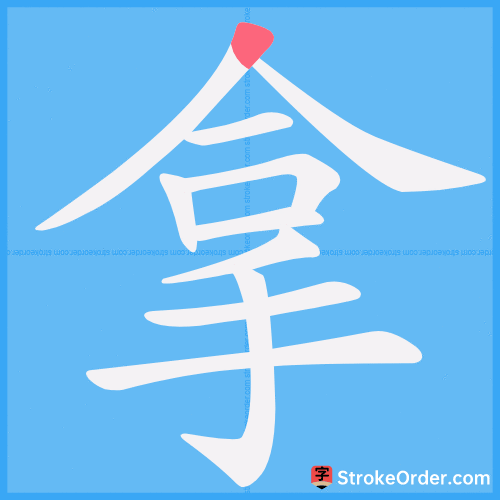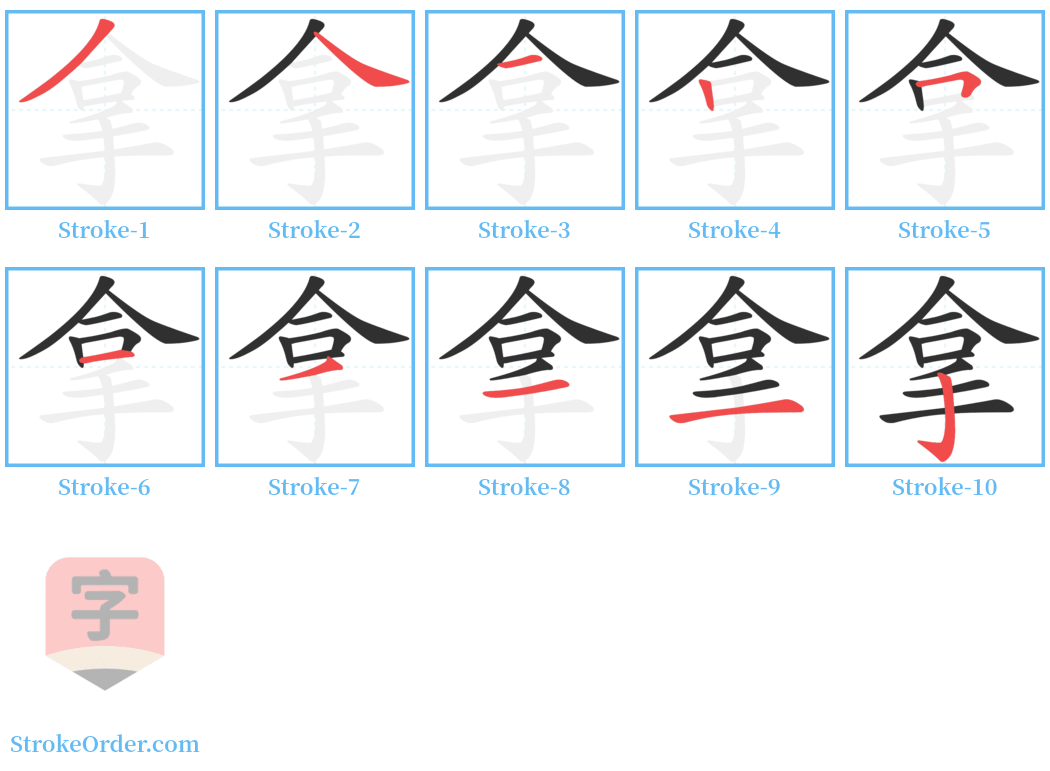拿 Stroke Order
Animated Stroke Order of 拿

Stroke Order Diagrams for 拿

Step-by-Step Handwriting Guide for 拿

Learn to Write Chinese Characters with Video Tutorials
Watch the video of writing the Chinese character "拿", learn the correct stroke order (笔顺) of the character "拿", and master the standard way of writing the character "拿".
Free Printable Handwriting Practice with Stroke Order: 拿
Printable Writing Practice Worksheet of "拿" in Portrait Orientation (Tian Zi Ge)

Printable Writing Practice Worksheet of "拿" in Landscape Orientation (Tian Zi Ge)

Information of 拿
Pinyin
ná
Radical
手
Strokes
10 strokes
Usage
★★★★★
Definition
to hold / to seize / to catch / to apprehend / to take
拿 (ná)
1. 用手取,握在手里。
[En.] To take with the hand, to hold in the hand.
Example: 拿笔。
[En.] Take (hold) a pen.
2. 掌握,把握。
[En.] To grasp, to master.
Example: 拿主意。
[En.] To grasp an idea.
3. 挟(xié)制。
[En.] To hold (someone) in check; to threaten.
Example: 拿捏。
[En.] To make things difficult for someone.
4. 侵蚀,侵害。
[En.] To erode, to harm.
Example: 让药水拿白了。
[En.] Let the medicine erode (damage) what’s white.
5. 逮捕,捉。
[En.] To arrest, to catch.
Example: 拿获。
[En.] To arrest; catch.
6. 攻下,占领。
[En.] To capture, to occupy.
Example: 一定要把敌人的碉堡拿下来。
[En.] Must capture the enemy's stronghold.
7. 介绍,引出对象,相当于“把”。
[En.] To introduce, to bring up a subject, equivalent to "把".
Example: 我拿你当亲人看待。
[En.] I regard you as a family member.
8. 介词,引出所凭借的工具、材料、方法等,相当于“用”。
[En.] A preposition introducing tools, materials, methods, etc., equivalent to "with".
Example: 拿笔来写。
[En.] Write with a pen.
9. 用…手段表现或运用权力。
[En.] To wield power or authority through means.
10. 提起; 举起; 抬; 吊。
[En.] To lift; to raise; to hoist.
Example: 他拿起脚就走了。
[En.] He lifted his foot and walked away.
This entry provides a comprehensive overview of the meanings and usages of the character "拿", demonstrating its versatility in both action and grammatical functions in the Chinese language.
Input Method for 拿
Pinyin
na2
Wubi
wgkr
Cangjie
orq
Zhengma
odjm
Four Corner
80502
Unicode
U+62ff
Same Pronunciation Characters